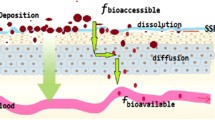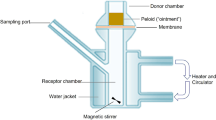Abstract
Even if dermal exposure to metal(loid)s from contaminated soils has received less attention than oral and inhalation exposure, the human health risk can be significant for some contaminants and exposure scenarios. The purpose of this study was to assess the influence of sebum proportion (1% v/v and 3% v/v) in two synthetic sweat formulations (EN 1811, pH 6.5 (sweat A) and NIHS 96–10, pH 4.7 (sweat B)) on As, Cr, Cu, Ni, Pb, and Zn dermal bioaccessibility and on subsequent diffusion through synthetic skin. A Franz cell with a Strat-M® membrane was used to quantify permeation parameters of bioaccessible metal(loid)s. Sebum’s presence in synthetic sweat formulations significantly modified bioaccessibility percentages for As, Cr, and Cu. However, sebum proportion in both sweats did not influence the bioaccessibility of Pb and Zn. Some metal(loid)s, namely As and Cu, permeated the synthetic skin membrane during permeation tests when sebum was added to sweat while no permeation was observed without sebum in sweat formulations. Depending on sweat formulation, the addition of sebum (1% v/v) increased or decreased the Cr permeation coefficients (Kp). In all cases, bioaccessible Cr was no longer permeable when extracted with 3% sebum. Ni transdermal permeation was not influenced by the presence of sebum, and no permeation was observed for Pb and Zn. Further studies on the speciation of metal(loid)s in bioaccessible extracts in the presence of sebum are recommended.
Graphical abstract

Similar content being viewed by others
Data availability
Additional data is available in the Supplementary Information section.
References
Abdel-Rahman MS, Skowronski GA, Turkall RM (2006) Impact of aging time on the dermal penetration of phenol in soil. Soil Sediment Contam: an Int J 14(2):123–134. https://doi.org/10.1080/15320380590911742
Adriano DC, Wenzel W, Vangronsveld J, Bolan N (2004) Role of assisted natural remediation in environmental cleanup. Geoderma 122(2–4):121–142
Anselm OH, Davidson CM, Oyeyiola AO, Oluseyi TO (2022) Effects of artificial sweat formulation and extraction temperature on estimation of the dermal bioaccessibility of potentially toxic elements in a contaminated soil from an e-waste recycling site. Geosciences 12(1):31. https://doi.org/10.3390/geosciences12010031
ASTM (1998) Standard guide for evaluating stain removal performance in home laundering. ASTM, West Conshohocken, PA
ASTM (2017) Standard test methods for particle-size distribution (gradation) of soils using sieve analysis. ASTM, West Conshohocken, PA
ASTM (2019) Standard test method for pH of soils. ASTM, West Conshohocken, PA
ASTM (2021) Standard test method for particle-size distribution (gradation) of fine-grained soils using the sedimentation (hydrometer) analysis. ASTM, West Conshohocken, PA
Beriro DJ, Cave MR, Wragg J, Thomas R, Wills G, Evans F (2016) A review of the current state of the art of physiologically-based tests for measuring human dermal in vitro bioavailability of polycyclic aromatic hydrocarbons (PAH) in soil. J Hazard Mater 305:240–259. https://doi.org/10.1016/j.jhazmat.2015.11.010
Callewaert C, Buysschaert B, Vossen E, Fievez V, Van de Wiele T, Boon N (2014) Artificial sweat composition to grow and sustain a mixed human axillary microbiome. J Microbiol Methods 103(Supplement C):6–8. https://doi.org/10.1016/j.mimet.2014.05.005
CEN (2015) Reference test method for release of nickel from all post assemblies which are inserted into pierced parts of the human body and articles intended to come into direct and prolonged contact with the skin. EN 1811. European Committee for Standardization
Chapman HD (1965) Cation-exchange capacity. In: Black CA(ed) Methods of soil analysis – Chemical and microbiological properties, vol 9. Madison, Agronomy, American Society of Agronomy, pp 891–901
Clesceri LS, Greenberg AE, Eaton AD (1999) Standard methods for the examination of water and wastewater, 20th edn. American Public Health Association, Washington, DC
Dobran S, Zagury GJ (2006) Arsenic speciation and mobilization in CCA-contaminated soils: influence of organic matter content. Sci Total Environ 364:239–250
Flint GN (1998) A metallurgical approach to metal contact dermatitis. Contact Derm 39(5):213–221
Franken A, Eloff FC, Du Plessis J, Du Plessis JL (2015) In vitro permeation of metals through human skin: a review and recommendations. Chem Res Toxicol 28:2237–2249
Franz TJ (1975) Percutaneous absorption. On the relevance of in vitro data. J Invest Dermatol 64:190–195
Gammelgaard B, Fullerton A, Avnstorp C, Menné T (1992) Permeation of chromium salts through human skin in vitro. Contact Dermatitis 27(5):302–310
Geiss O, Bianchi I, Senaldi C, Lucena A, Tirendi S, Barrero-Moreno J (2018) Skin surface film liquid as new migration medium for the determination of PAHs released from rubber containing consumer goods. Polycyclic Aromat Compd 40(1):1–10. https://doi.org/10.1080/10406638.2018.1458742
Gosselin M, Zagury GJ (2019) Metal(loid)s inhalation bioaccessibility and oxidative potential of particulate matter from chromated copper arsenate (CCA)-contaminated soils. Chemosphere 238:124557. https://doi.org/10.1016/j.chemosphere.2019.124557
Gray H (2000) Anatomy of the human body. Philadelphia: Lea & Febiger, 1918; Twentieth ed. Bartleby.com
Guy RH (2016) Metals and the skin: topical effects and systemic absorption. CRC Press, Boca Raton, FL
Haq A, Dorrani M, Goodyear B, Joshi V, Michniak-Kohn B (2018a) Membrane properties for permeability testing: skin versus synthetic membranes. Int J Pharm 539:58–64
Haq A, Goodyear B, Ameen D, Joshi V, Michniak-Kohn B (2018b) Strat-M® synthetic membrane: permeability comparison to human cadaver skin. Int J Pharm 547(1–2):432–437. https://doi.org/10.1016/j.ijpharm.2018.06.012
Hostynek JJ, Maibach HI (2006) Skin penetration by metal compounds with special reference to copper. Toxicol Mech Methods 16(5):245–265
Hostynek JJ, Dreher F, Maibach HI (2011) Human skin penetration of a copper tripeptide in vitro as a function of skin layer. Inflamm Res 60(1):79–86
Khelifi F, Caporale AG, Hamed Y, Adamo P (2021) Bioaccessibility of potentially toxic metals in soil, sediments and tailings from a north Africa phosphate-mining area: insight into human health risk assessment. J Environ Manage 279:111634. https://doi.org/10.1016/j.jenvman.2020.111634
Larese F, Gianpietro A, Venier M, Maina G, Renzi N (2007) In vitro percutaneous absorption of metal compounds. Toxicol Lett 170:49–56. https://doi.org/10.1016/j.toxlet.2007.02.009
Leal LTC, Guney M, Zagury GJ (2018) In vitro dermal bioaccessibility of selected metals in contaminated soil and mine tailings and human health risk characterization. Chemosphere 197:42–49
Liang S, Guan D-X, Li J, Zhou C-Y, Luo J, Ma LQ (2016) Effect of aging on bioaccessibility of arsenic and lead in soils. Chemosphere 151:94–100
Marin Villegas CA, Zagury GJ (2021) Comparison of synthetic sweat and influence of sebum in the permeation of bioaccessible metal(loid)s from contaminated soils through a synthetic skin membrane. Environ Sci Technol 55:8215–8222
Marin Villegas CA, Guney M, Zagury GJ (2019) Comparison of five artificial skin surface film liquids for assessing dermal bioaccessibility of metals in certified reference soils. Sci Total Environ 692:595–601
McLean JE, Bledsoe BE (1992) Ground water issue: behavior of metals in soils. EPA/540/S-92/018, Office of Solid Waste and Emergency Response, US EPA, Washington, DC
Miller T (2009). Chapter 14 - Clinical testing to uphold an anti-aging claim. In: Dayan N (ed) Skin aging handbook. William Andrew Publisher, pp 363–389. https://doi.org/10.1016/B978-0-8155-1584-5.50018-1
Ministère de l’Environnement et de la Lutte contre les changements climatiques (2021) Guide d’intervention - Protection des sols et réhabilitation des terrains contaminés. Annexe 2. https://www.environnement.gouv.qc.ca/sol/terrains/guide-intervention/guide-intervention-protection-rehab.pdf. Accessed 10 June 2022
Pelfrêne A, Douay F (2018) Assessment of oral and lung bioaccessibility of Cd and Pb from smelter-impacted dust. Environ Sci Pollut Res 25(4):3718–3730
Reeder RJ, Schoonen MAA, Lanzirotti A (2006) Metal speciation and its role in bioaccessibility and bioavailability. Rev Mineral Geochem 64(1):59–113. https://doi.org/10.2138/rmg.2006.64.3
Ruby MV, Schoof R, Brattin W, Goldade M, Post G, Harnois M, Carpenter M (1999) Advances in evaluating the oral bioavailability of inorganics in soil for use in human health risk assessment. Environ Sci Technol 33(21):3697–3705
Senila M, Levei E, Cadar O, Senila LR, Roman M, Puskas F, Sima M (2017) Assessment of availability and human health risk posed by arsenic contaminated well waters from Timis-Bega area, Romania. J Anal Methods Chem, Article ID 3037651. https://doi.org/10.1155/2017/3037651
Stefaniak AB, Harvey CJ (2006) Dissolution of materials in artificial skin surface film liquids. Toxicol in Vitro 20(8):1265–1283
Stefaniak AB, Duling MG, Geer L, Virji MA (2014) Dissolution of the metal sensitizers Ni, Be, Cr in artificial sweat to improve estimates of dermal bioaccessibility. Environ Sci Process Impacts 16(2):341–351. https://doi.org/10.1039/c3em00570d
Stefaniak AB, Harvey CJ (2008) Artificial skin surface film liquids. Patent US 20080311613 A1. https://www.google.com/patents/US20080311613. Accessed 20 Mar 2022
Townsend T, Solo-Gabriele H, Tolaymat T, Stook K, Hosein N (2003) Chromium, copper, and arsenic concentrations in soil underneath CCA-treated wood structures. Soil Sediment Contam: an Int J 12(6):779–798. https://doi.org/10.1080/714037715
USEPA (1995) Contaminants and remedial options at selected metal-contaminated sites. EPA/540/R-95/512. Washington, DC
USEPA (2004) Risk assessment guidance for superfund volume I: human health evaluation manual (part E, supplemental guidance for dermal risk assessment). EPA/540/R/99/005. Washington
USEPA (2011) Exposure factors handbook: 2011 edition. EPA/600/R-090/052F. Washington
Van der Kallen CC, Gosselin M, Zagury GJ (2020) Oral and inhalation bioaccessibility of metal(loid)s in chromated copper arsenate (CCA)-contaminated soils: assessment of particle size influence. Sci Total Environ 734:139412
Wainman T, Hazen RE, Lioy PJ (1994) The extractability of Cr (VI) from contaminated soil in synthetic sweat. J Expo Anal Environ Epidemiol 4(2):171–181
Wang J, Gao P, Li M-Y, Ma J-Y, Li J-Y, Yang D-L, Cui D-L, Xiang P (2022) Dermal bioaccessibility and cytotoxicity of heavy metals in urban soils from a typical plateau city: implication for human health. Sci Total Environ 835:155544. https://doi.org/10.1016/j.scitotenv.2022.155544
Wertz PW (2009) Human synthetic sebum formulation and stability under conditions of use and storage. Int J Cosmet Sci 31:21–25
Acknowledgements
The authors acknowledge the technical support provided by Jérôme Leroy and Zohra Laimeiche (Polytechnique Montréal) and Lan-Huong Tran (INRS-ETE).
Funding
The study was financially supported by the Natural Sciences and Engineering Research Council of Canada (NSERC) obtained via the Discovery Grant Program (RGPIN-2022–03225).
Author information
Authors and Affiliations
Contributions
All authors contributed to the study conception and design. Material preparation and data collection were performed by Florent A. Ghislain. Data analysis was performed by Florent A. Ghislain and Gérald J. Zagury. The first draft of the manuscript was written by Florent A. Ghislain, and all authors commented on previous versions of the manuscript. The submitted version was revised by Gérald J. Zagury. Funding was obtained by Gérald J. Zagury. All authors read and approved the final manuscript.
Corresponding author
Ethics declarations
Ethical approval
Not applicable.
Consent for publication
All co-authors permitted the submission of this manuscript to to Environmental Science and Pollution Research. Besides, all authors read the manuscript and accept responsibility for its content.
Consent to participate
Not applicable.
Conflict of interest
The authors declare no competing interests.
Additional information
Responsible Editor: Kitae Baek
Publisher's note
Springer Nature remains neutral with regard to jurisdictional claims in published maps and institutional affiliations.
Highlights
• As, Cu, and Cr dermal bioaccessibility was influenced by the presence of sebum in sweat formulations.
• As and Cu were able to permeate synthetic skin only when extracted with a mixture of sweat and sebum.
• Cr permeation coefficient was clearly affected by sebum presence in sweat formulations but without consistent trend.
• Ni could permeate synthetic skin when extracted with and without sebum.
• No permeation was observed for Pb and Zn.
• The effect of sebum in sweat formulations on bioaccessibility and permeation was metal, soil, and sweat-dependent.
We have not submitted our manuscript to a preprint server before submitting it to Environmental Science and Pollution Research.
Supplementary Information
Below is the link to the electronic supplementary material.
Rights and permissions
Springer Nature or its licensor (e.g. a society or other partner) holds exclusive rights to this article under a publishing agreement with the author(s) or other rightsholder(s); author self-archiving of the accepted manuscript version of this article is solely governed by the terms of such publishing agreement and applicable law.
About this article
Cite this article
Ghislain, F.A., Zagury, G.J. Influence of sebum proportion in synthetic sweat on dermal bioaccessibility and on permeation of metal(loid)s from contaminated soils. Environ Sci Pollut Res 30, 86762–86772 (2023). https://doi.org/10.1007/s11356-023-28388-x
Received:
Accepted:
Published:
Issue Date:
DOI: https://doi.org/10.1007/s11356-023-28388-x




